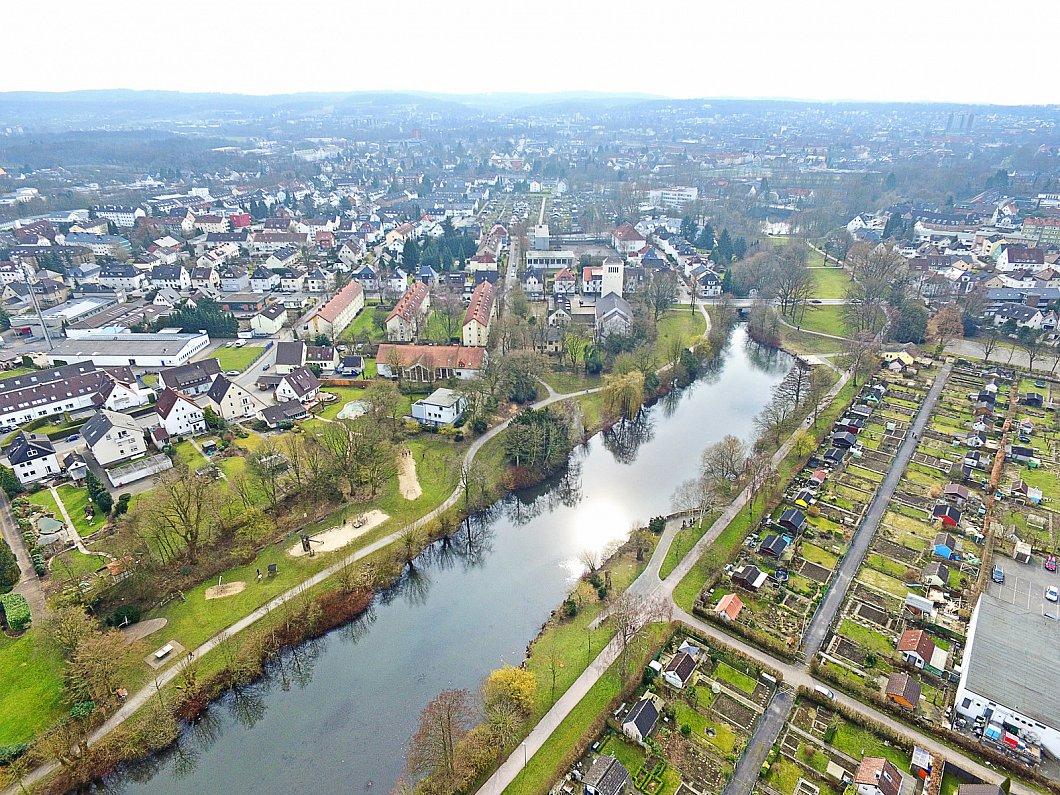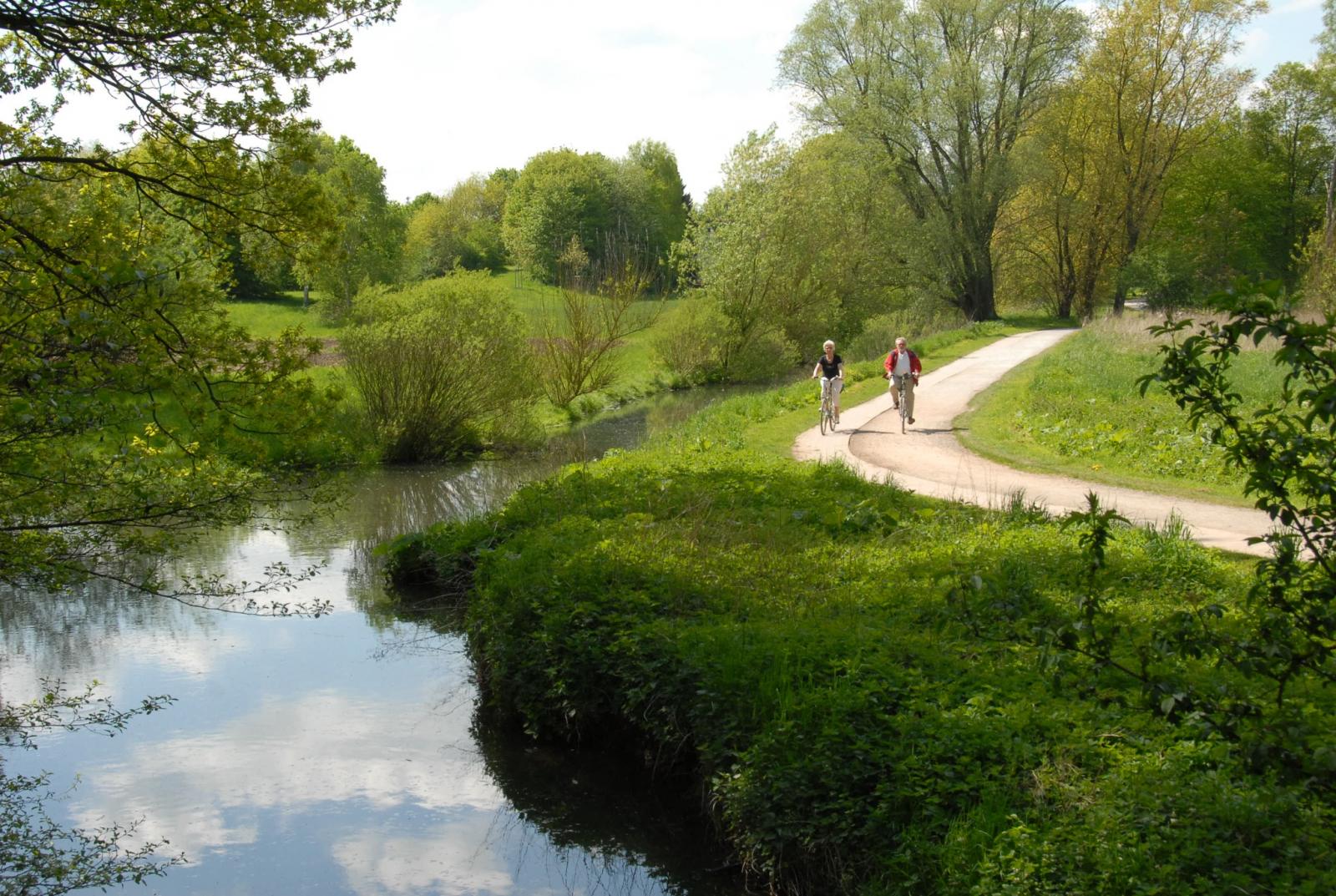With its parking areas, ponds, the Lutter stream, playground facilities, walking and jogging paths, the green corridor of Bielefeld, called Luttergrünzug offers recreation opportunity to around 36, 000 people, living in the surrounding areas. As a link between the eastern city center and the district of Heepen, it also enables walking and cycling routes for commuting and shopping away from the busy streets of the city (7). However, the green corridor has been showing some structural and functional defects such as the silting up of the ponds, conflicts between pedestrians and cyclists and the increasing overgrowth of the green belt (8). In order to solve these problems, the renovation and redesign of the Green Corridor was proposed. The regeneration project addresses different needs and requirements of the municipality, namely providing the comfortable infrastructure for pedestrians and cyclists, and the increase of attractiveness of the neighbouring residential areas. In the planning process, special attention was paid to the improvement of the draining system and the reservoirs of the area that will protect the Belt from flooding. (8) Two regeneration plans were developed with citizens' involvement and presented to the political committee. In 2017, the implementation of the "smaller" variant was voted for, which was already presented in the first citizens' workshop (1, 4).
Overview
Nature-based solution
- Grey infrastructure featuring greens
- Blue infrastructure
- Riverbank/Lakeside greens
- Parks and urban forests
- Green corridors and green belts
- Community gardens and allotments
- Allotments
- Rivers/streams/canals/estuaries
- Green areas for water management
- Sustainable urban drainage systems
Key challenges
- Climate action for adaptation, resilience and mitigation (SDG 13)
- Climate change adaptation
- Water management (SDG 6)
- Flood protection
- Green space, habitats and biodiversity (SDG 15)
- Habitat and biodiversity conservation
- Green space creation and/or management
- Environmental quality
- Air quality improvement
- Regeneration, land-use and urban development
- Regulation of built environment
- Health and well-being (SDG 3)
- Creation of opportunities for recreation
Focus
Project objectives
Implementation activities
Climate-focused activities
Climate change adaptation:
- Increase or improve urban vegetation cover to help reduce outdoor temperature
- Restore wetlands and/or coastal ecosystems to dissipate the effects of flooding and/or storms
- Implement sustainable urban drainage infrastructure (e.g. to make space for water)
- Renaturalization of rivers and other water bodies
Biodiversity conservation or restoration-focused activities
Biodiversity conservation:
- Protect and enhance urban habitats
- Preserve and strengthen existing habitats and ecosystems
- Reduce negative impacts and avoid the alteration/damage of ecosystem
- Protect species
- Undertake specific measures to protect species
- Undertake specific measures to protect native species
- Undertake specific measures to protect valued species
Main beneficiaries
- Local government/Municipality
- Public sector institution (e.g. school or hospital)
- Citizens or community groups
- Marginalized groups: Elderly people
- Young people and children
Governance
Management set-up
- Co-governance with government and non-government actors
Type of initiating organisation
- Local government/municipality
- Private sector/corporate actor/company
- Citizens or community group
Participatory approaches/ community involvement
- Co-planning (e.g. stakeholder workshops, focus groups, participatory mapping)
- Dissemination of information and education
- Consultation (e.g. workshop, surveys, community meetings, town halls)
Details on the roles of the organisations involved in the project
Project implemented in response to ...
Financing
Total cost
Source(s) of funding
- EU funds
- Public local authority budget
- Funds provided by non-governmental organization (NGO)
- Private Foundation/Trust
Type of funding
- Direct funding (grants, subsidies, or self-financed projects by private entities)
- Membership or entrance fees
Non-financial contribution
Impacts and Monitoring
Environmental impacts
- Climate change
- Lowered local temperature
- Environmental quality
- Improved air quality
- Water management and blue areas
- Increased protection against flooding
- Enhanced protection and restoration of freshwater ecosystems
- Green space and habitat
- Promotion of naturalistic styles of landscape design for urban development
- Increased green space area
- Increased conservation or restoration of ecosystems
- Increased number of species present
- Increased ecological connectivity across regeneration sites and scales
Economic impacts
- Unknown
Socio-cultural impacts
- Social justice and cohesion
- Improved access to urban green space
- Health and wellbeing
- Gain in activities for recreation and exercise
- Cultural heritage and sense of place
- Improvement in people’s connection to nature
- Education
- Increased knowledge of locals about local nature
- Other
Type of reported impacts
Presence of formal monitoring system
Presence of indicators used in reporting
Presence of monitoring/ evaluation reports
Availability of a web-based monitoring tool
References
2. Bielefeld. (2020). Luttergrünzug: Bürgerbeteiligung. Accessed August 28, 2020, Source link.
3. Bielefeld. (2020). Rahmenkonzept Luttergrunzug Bielefeld. Accessed August 28, 2020, Source link.
4. Green Corridor Variant A. (2017).
5. Green Corridor Variant B. (2017).
6. Bielefeld. (2017). Freiraumplanerisches Rahmenkonzept
Luttergrünzug. Accessed August 28, 2020, Source link
7. Bielefeld. (2020). Luttergrünzug: Von der Innenstadt bis Heepen. Accessed August 28, 2020, Source link
8. Bielefeld. (2020). Luttergrünzug: Der Luttergrünzug im Wandel, Accessed August 28, 2020, Source link
9. Bielefeld. (2020). Luttergrünzug: Aktuelles und Termine, Accessed August 28, 2020 Source link
10. Bielefeld. (2018). Luttergrünzug: Niederschrift über die Sitzung des Ausschusses für Umwelt und Klimaschutz am 05.07.2018, Accessed August 28, 2020, Source link
11. Bielefeld. (2017). Freiraumplanerisches Rahmenkonzept Luttergrünzug Ergebnisbericht, Teil 1, Accessed August 28, 2020, Source link
12. Bielefeld. (2017). Freiraumplanerisches Rahmenkonzept Luttergrünzug Ergebnisbericht, Teil 2, Accessed August 28, 2020, Source link
13. Ahlers, J. (2018). Zukunft der Stauteiche: Was die Anwohnern von den Plänen halten. Neue Westfälische, Accessed August 28, 2020, Source link
14. Hörttrich, B. (2018). Lutter-Grünzug: Statt neuer Wegeverbindung erst neue Spielplätze. Westfalen-Blatt, Accessed August 28, 2020, Source link
15. Schläger, M. (2018). Kompromiss: Die Schrebergärten am Stauteich III bleiben erhalten - Kein Luttersee und auch keine Wohnhäuser. Westfalen-Blatt, Accessed August 28, 2020, Source link



